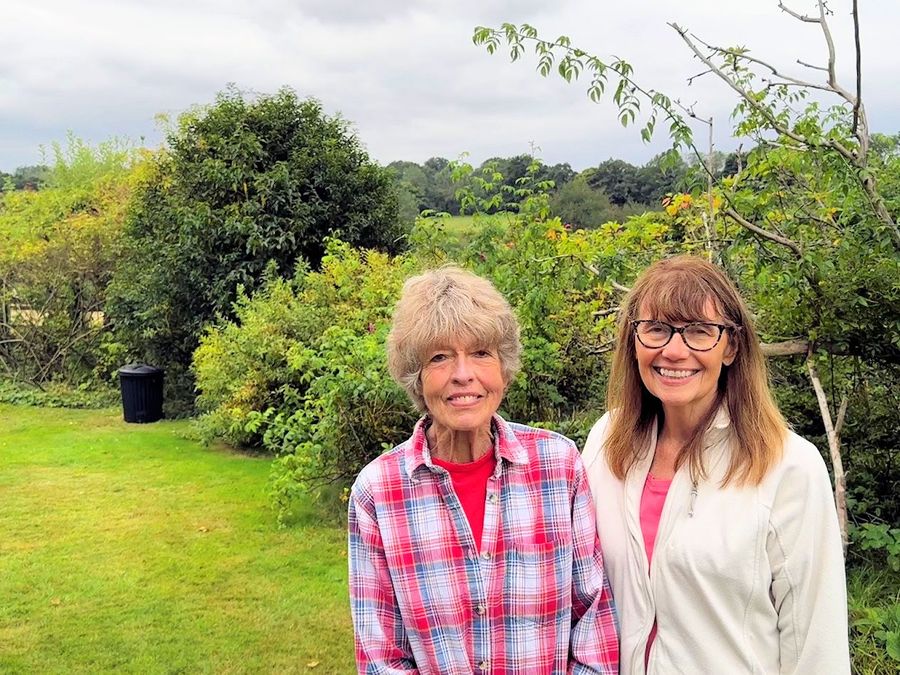A VISIT TO A BEAUTIFUL TINY CHAPEL, WE LAY FLOWERS ON MY SISTER’S GRAVE, AND TOUR THE GERMAN UNDERGROUND HOSPITAL, A SOBERING REMINDER OF GUERNSEY’S OCCUPATION DURING WORLD WAR II

When my nephew Steve suggested we drive to “The Little Chapel” I was thrilled as it many years since our last visit. My sister Patty took Marla and I to see it my very first Guernsey trip on a cold and wet January day. The Little Chapel is situated in the Les Vauxbelets Valley, in Saint Andrew Parish.

Originally created in 1914 by Brother Deodat who wanted to build a miniature version of the grotto and the Rosary Basilica at Lourdes, he destroyed and reconstructed it three times until he felt it was just right.
This is a charming video presentation of the Little Chapel.

Marla and Paxton inside the chapel. The decoration is called “Picassiette“, with seashells, pebbles, and broken china.

The Little Chapel is one of Guernsey’s most visited landmarks welcoming guests from around the world.

The broken shards have been creatively set to form a sublime mosaic.

Marla exits the Chapel after exploring the tiny interior.

It was so much fun sharing this place with Paxton.

We cannot make a trip to Guernsey without visiting my sister’s gravesite. Paxton, Marla, and Steve walk through the portals of the Le Foulon Cemetery.

The cemetery first opened in the 19th century and is just down the street from my sister’s home.

This was a time for reflection and remembrance. My sister Patty made many sacrifices for me when I was growing up in California.

We approach the entrance German Underground Hospital in La Vassalerie, Castel, Guernsey.

Steve, wife Karen, Marla and Paxton enter a tunnel in underground hospital. The German Underground Hospital and Ammunition Store is the largest structural reminder of the German Occupation existing in the Channel Islands. The maze of tunnels cover an area of about 75,000 square feet. The dank and cold atmosphere create an eerie and dark mood.

During the German Occupation between 1940 to 1945, hundreds of slave laborers were brought to the island to build many military fortifications and the underground hospital. The immense prisoner of war labor force were known as “TODT” workers (after a German civil engineer Dr. Fritz Todt.) and came from all over Europe, especially Poland and Russia. Many of them died in the tunnels’ construction, using explosives, drills, hand tools, and their bare hands to carve these tunnels from solid rock. They faced terrible suffering and appalling conditions.

Steve looks at various cemeteries from the war. Many islanders took great pity on the workers by feeding them, giving medical aid, and even hiding them in their homes. This was an extremely dangerous form of kindness.

By the time construction ceased at the onset of the D-Day invasion, the hospital complex was large enough to house 500 patients and included facilities such as an operating room, X-ray room, dispensary, laboratory, and staff quarters, as well as a cinema, central heating plant, and kitchen. In addition to the three main entrances, the ventilation shafts were equipped with stairs and ladders so they could double as emergency exits.
The Underground Hospital was actually used for only about three months. During the summer of 1944 German casualties of the D-Day invasion filled all available wards. Hospital operations were moved above ground when it became clear that the tunnels’ damp, dark and cold atmosphere was not conducive to recovery.

Paxton peers into one of the tunnels.

The treatment of the remaining Jews on Guernsey was a sad education for all of us. There was no escaping the Nazi’s demented anti-semitic treatment of the Jews during the Occupation.

I can’t imagine the difficulty digging these tunnels by the slave laborers!

There were many stories of bravery by the islanders during the time of the German occupation. I kept thinking whether I could be as brave as so many during this time.

The tour was uncomfortable on multiple levels, both physically and emotionally. We wanted it to end…yet we all wanted to know more of the history.

The sign on the wall says “Unauthorized access prohibited.”
This is a YouTube video for those wanting to know more about 6000 years on Guernsey.

There is so much more to see of this wonderful island, but the day came when it was time to leave. Marla helps Paxton check in his luggage for the Aurigny Airline back to London Gatewick.

Paxton was only one-year-old on his last Guernsey visit so this was very special for all of us! Marla and I took a later flight.

The view of St. Peter Port.

I always leave the island with a mix of joy…and sadness. It was wonderful to spend blissful family time with Suzanne, Chris, Vic, Steve, Karen, Paxton and Marla. I hope on our next trip we can share this special place with other members of the family!
On the next episode of Gentry Connects I will share experiences on our very first visit to…Athens.
"Ελα μαζί μας"..."Come join us." Photos: Dick Gentry...Not to be used without permission.
About The Author
admin
Related Posts
BANGKOK ADVENTURES…VISITING A SIMPLY GORGEOUS RESTAURANT, MARLA AND LISA DANCING ON STAGE, AND THE MOST UNUSUAL SHOPPING CENTER I’VE EVER SEEN.
Our Bangkok explorations continue with a simply superb lunch at the beautiful Blue Elephant Restaurant…
October 14, 2022VISITING OUR GOOD FRIEND LINDA IN BEAUTIFUL BRAZIERS END, CHOLESBURY, ENGLAND
After our little holiday on the island of Guernsey we flew back to England and…
October 14, 2022

Leave A Comment